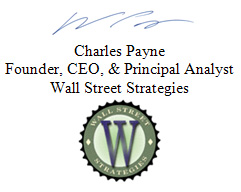Getting Started with Options
By Charles Payne, CEO and Principal Analyst, Wall Street Strategies
After the stock market crashed and burned in the post bubble era, a lot of money was lost, some say trillions. Those few investors left that still wanted to venture forward had smaller pools of funds to do so. That's when I saw a serious migration into options.
Options offer incredible leverage, but also incredible risk. The reason Wall Street is teetering is because of excess use of leverage. So before I explain options 101, I must underscore it is a very DANGEROUS game. I'm really not a big fan of options because most people get greedy or don't have the discipline to take losses. In fact, the only way to really make money in options is to be able to take losses without regret. You will look back and see all the winners you could have had if you held and suspend the reality of the massive losses you would have endured as well.
An option gives the owner the right to buy or sell a stock at a specific price (strike) within a specific time frame. So August 200 calls on Goldman Sachs means one has the right to buy the stock between now and the third Friday in August at $200.00 even if the stock is trading at $250.00. Each contract represents 100 shares of stock. The pricing of options is based on several things.
1. Intrinsic value, simply the raw worth of the options
2. Time premium, which adds to the value of and option based on how far into the future it covers
3. Demand and liquidity
Typically, we prefer that investors go conservative with options trades which means buying an option that has a strike price that is not far from the current share price and going out three to five months in the future.
Option trading parameters for the Hotline will contain the Type of Option (Call or Put), the Option Symbol, the Entry Price, the Target Price, and the Expiration Date of the option.
Here are three recent successful option ideas featured on our Hotline Service.
| Cymer, Inc. (CYMI) | Stock | Option | | Buy | 44.40 | 3.70 | | Sell | 52.23 | 6.50 | | Percentage Return | 17% | 75% |
| ASML Holding NV (ASML) | Stock | Option | | Buy | 38.42 | 3.50 | | Sell | 42.29 | 5.80 | | Percentage Return | 10% | 65% |
| DSW Inc. (DSW) | Stock | Option | | Buy | 34.99 | 2.99 | | Sell | 41.07 | 6.30 | | Percentage Return | 17% | 110% |
The Real Deal
I'm on record saying: "Options are a sucker's game". The fact is I think that statement can be true for the majority of people buying options with the notion they'll strike it rich, when in fact they should endeavor for big wins (in baseball parlance, doubles and triples) and the homeruns will come naturally. The key, however, is to accept when one has struck out. Unlike the game of baseball the option holder gets to decide when his position has whiffed. If one waits too long then the price of the option can move to zero by the time expiration comes around. If the holder sells too soon the underlying stock could surge and those options could jump out of the ballpark like rocket shot off the bat of Alex Rodriquez.
Before we get into the nitty-gritty of managing options lets look into the basis of options and what makes them tick. I've taken my comments on stock options from my book "Be Smart Act Fast Get Rich".
Excerpt
Watching the Puts and Calls
Stock options are a good tool for playing the stock market when you're a buyer and an even greater tool for managing investments when you are writing (selling) them. I'm not going to get too deep into stock options from a strategic point of view simply because I'd be doing you a disservice; there are so many esoteric ways to incorporate options into your investment scheme that describing them would take an entire book.
Suffice it to say, I worry when investors buy stock options as their only method for engaging the stock market. If you are doing this then you are playing the market, not investing, and the game is more akin to Russian roulette then Monopoly. Still, I understand the appeal. The returns are up there with winning the lottery- some options are up several hundred percent in a single session.
When you're watching a stock that has seen a spike in volume and there is no news from the company or any of its rivals, or any other development that would have a material impact on the company, its time to take a look at the options activity. There are two basic elements to that you need to understand.
Calls give the holder the right to buy 100 shares in the underlying company for each contract, at a predetermined share price (strike price or strike) and by a specific period of time (expiration date).
Puts give the holder the right to sell 100 shares in the underlying company for each contract, at a predetermined share price (strike price or strike) by a specific period of time (expiration date).
Stock options are contracts that are traded, but they do expire (die on the vine), and this is a point that doesn't seem to dawn on many investors. Sure, you could hold an option to the expiration date and choose to take advantage of the terms of the option, but more than likely you would have already traded it away.
Drivers of Stock Options
The pricing of stock option is science with a fair amount of art mixed in for good measure. We begin with intrinsic value; the core value of the option based on the strike price and the actual price of the stock. For instance, a strike price of $35 on a stock trading at $38 has intrinsic value of $3. Then comes the layers of premium add through a number of factors:
Time premium Since time is money, the farther out the expiration, the more expensive the option. In November, the February calls will inherently be more expensive than the December calls, assuming the same exact strike price. You have to pay for the privilege of time.
Volatility or volume When there is more demand and liquidity, options tend to fetch higher prices and therefore the stock doesn't have to move as much to see a marked difference in the appreciation of the option. When buyers are standing by, the price of a stock option is likely to hold up more than for an option with few to no available buyers.
Because the payoff in options can be astronomical, speculators will often load up on them in hopes of early retirement. However, the really big bets in stock options aren't from some guy who just got tired of schlepping to the off-track betting parlor. The real action comes from the big boys, those hedge fund and other money manager types who are looking for the big score, too.
What Else?
In addition to the excerpt above option pricing also includes the volatility of the underlying stock, which I alluded to in the book. Stocks that gyrate rapidly are known as high Beta stocks. This rating of a stock is important to know and monitor. As a rule of thumb the magic Beta number is 1.0, as ratings move higher it is indicative of a more volatile stock and hence a more volatile option. This is important to remember.
Keep in mind options are dangerous and as they move lower at a fast pace investors are going to get a lump in their throat. Before buying an option make sure you understand the Beta because if you have a low risk tolerance that option or options in general could be the wrong vehicle for you. Moreover, when it comes to taking losses one has to make greater exceptions (i.e. take bigger risks) with options attached to high Beta stocks.
Also keep in mind the amount of interest you're paying with options since there are such expenses that must be paid to the brokerage firm to execute options trades.
So here is where we stand:
You buy a call or put based on which direction you think the stock is heading. You think the stock will make a sharp move within a short period of time and want the leverage of stock options to score big. So, you pull the trigger. Now, its time for you to begin management of the trade, this is when the real challenge begins.
You Must
Monitor the stock and make sure the factors for pulling the trigger are still in place. These factors could include:
- Technical formations and reactions (did the stock bounce off a double bottom?)
- Volume action and breakouts
- News arrives and the stock reacts (the company post earnings and guidance you expected)
If the stock doesn't reverse at a double bottom, fails to breakout, goes down on earnings when you thought it would go up then you have to take a loss- immediately. If volume begins to fade and the stock begins to drift it might be time to close that option.
Exiting
I love to exit into strength with equity positions and options, too. If you're one of those people that frets over how much more you could have made if you held an hour or even a week longer then at some point that need to get every penny is going to lead to disaster.
We believe in taking profits and start to consider doing so once the stock is up more than 20%. This doesn't mean we pull the trigger but it is now an option (no pun intended). From this point we will not let this idea become a loser. So, if the option pulls back to unchanged then we will exit.
If an option on a stock with a Beta of 1.2 or less is down 20% we will more than likely take an automatic loss.
If an option on a stock with a Beta above 1.2 is down 20% more than likely we'd hold depending of course on other factors like news and to a lesser extent the action in the broad market (news of rivals or industry is lumped in with company news). We will exit the high Beta option at a loss of 40%, that is out pain threshold and also level where we want to have enough funds to come back and play again.
Options Trading Alert Emails
Please note that you will need to opt in to receive trading alert emails on options. To opt in to the options trading alerts, go to "Your Account" in the main navigation and click on "Trading Alert Emails". In the yellow box, select "Yes" and click the "Update Option Alerts" button. Click here to update your option alert preferences
Conclusion
I think options are a sucker's game if you only buy them and go for the grand slam. They are great when you have a diversified portfolio of them along with stocks and also learn to write them to hedge and protect profits. As I mentioned in my book there are tons of ways to play options and I hope the information above gives you a good start. You have to be honest and smart and unbowed. You have to take a loss and be willing to get right back into the game and you can't lament on what you could have made.
Have more questions?
We are here to help and want you to have success with your subscription. Please contact us at help@wstreet.com with any questions or comments.
 |
|
 |
 |



